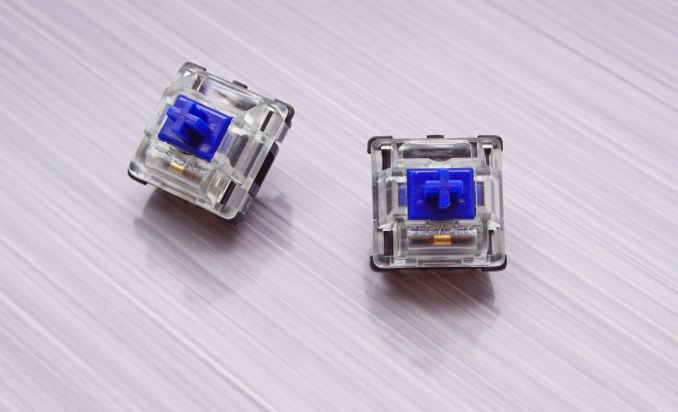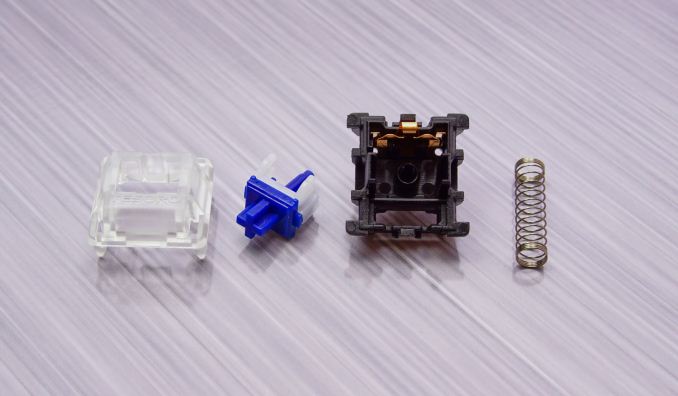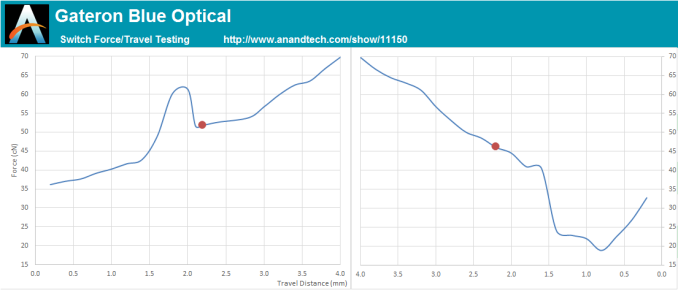The Tesoro Excalibur SE Spectrum Review: A Mechanical Keyboard with Gateron Optical Switches
by E. Fylladitakis on March 20, 2017 9:00 AM ESTThe Gateron Optical Switch
Gateron’s optical switches physically resemble the classic Cherry MX switch and, much like regular mechanical switches with electrical contacts, they are available in several different variations. The switches that our sample came with copy the features of the Cherry MX Blue switch, which has audible and tactile actuation feedback. Externally, Gateron’s only upgrade is the clear top frame of the switch that allows for the LED lighting to be diffused and evenly distributed around the switch.
The similarities of the Gateron optical switch to regular mechanical switches are more than just its physical dimensions. Inside we found an almost complete mechanical switch, with a typical metallic spring, a plastic stem and guides, and even one metal contact leaf. There is just one leaf because the switch does not rely on these metallic parts to generate a signal, but the leaf is only needed to emulate the clicky, audible behavior of the blue-type switch. An infrared sensor (on the keyboard’s PCB) optically reads the position of the stem and sends an actuation signal once it has reached a specific travel point. In the case of this particular switch, the actuation point is 2 mm below the reset point and the keys have a total travel of 4 mm.
In terms of performance and behavior, the Gateron Blue Optical switch almost perfectly copies the Cherry MX Blue switch variant. It has a relatively high operating force that slightly exceeds 61 cN, with the actuation point being about 0.15 mm after the peak force point. The distinct difference is the reset point of the switch, which is at almost exactly the same travel point as that of the actuation. The mechanical switch would have a reset point significantly above the actuation point, at about 1.5 mm before the reset (top) position of the switch.













21 Comments
View All Comments
MobiusPizza - Monday, March 20, 2017 - link
Currently, the only advantage over mechanical contacts apart from shorter travel. What they should aim for is programmable characteristics such as what travel distance activates the switch, as the sensor is capable of measuring the analogue movement.WorldWithoutMadness - Monday, March 20, 2017 - link
This one won't chatter like the traditional one.Kutark - Thursday, April 6, 2017 - link
So is it significantly quieter than a mechanical? I have a friend who continues to buy these horrifically bad Chiclet type keyboards because they have a very low actuation distance and are relatively quiet. He bitches constantly about how loud my keyboard is, so I can't even get him to try one out because of that.This sounds like it might be a good alternative option?
Old_Fogie_Late_Bloomer - Monday, March 20, 2017 - link
The advantage is that you don't need to wait for the switches to settle before decoding a keystroke, which in theory should lower latency. I dunno if that will really benefit anyone but competitive Korean StarCraft players, but that's the point of them.I use a Code Green primarily for my personal computing, where as long as I don't get strokes registering twice I'm happy and don't care about the slightly longer latency. But I'd definitely be interested in a red-equivalent optical switch for gaming (I have a Gateron Brown board for this but haven't had a lot of time to play lately).
Personally, I don't know why anyone markets blue switches to gamers, but obviously people are buying them. I find the mechanics of MX Greens to be an impediment for twitchy play, myself.
KAlmquist - Monday, March 20, 2017 - link
Why is it necessary to “wait for the switches to settle before decoding a keystroke?” When a mechanical switch closes, the contacts can bounce, causing the switch to open and close several times. So, the first time a switch closes, the keyboard reports the closing of the switch as a keystroke. The keyboard logic then has to identify the subsequent openings and closings as caused by contact bounce, which it does based on time. So the debouncing logic in the keyboard shouldn't introduce latency unless you manage to type quickly enough to confuse the debouncing logic. In particular, if you press a key and then release it really fast, the switch open caused by releasing the key could be confused with a contact bounce, causing the keyboard circuitry to delay reporting the key release until a timeout causes it to realize that it's not observing a contact bounce after all. But that's a delay in reporting a key release, not a key press, and I doubt that it happens in practice.sor - Tuesday, March 21, 2017 - link
A required delay in a key release is also a delay in the next key press. Probably not really any issue in practice, however, unless you like to type the same character at a rate of 100/second or more.sor - Tuesday, March 21, 2017 - link
For both keyboards it's required that the key travel backward 2mm to register a release, that's probably the limiting factor and introduces more than enough time to register debounce.SodaAnt - Monday, March 20, 2017 - link
How is the PWM on the RGB LEDs? I've seen a few keyboards where you get the rainbow effect if you move your vision on the keyboard too quickly, and the colors all end up splitting because the refresh rate is so low.pjcamp - Monday, March 20, 2017 - link
"The concept of making it plug & play, allowing the user to program lighting modes and macros without relying on software, is interesting..."I need to correct your typo here. It is not an interesting feature, it is REQUIRED in order to fully function with operating systems other than Windows. The folks down at Anandtech should recognize the existence of people who use Linux and Macs. When I bought my last keyboard, I spent a long time pouring over technical docs specifically to find one that was independent of Windows.
twtech - Monday, March 20, 2017 - link
And yet still, there is no MS Natural type split keyboard equivalent with mechanical keys. Considering the MS Natural shape & style remains the keyboard style of choice for many programmers and others that type all day, it seems like this should have been an obvious market to target.There are a few ergonomic mechanical keyboards, but most of them have nonstandard key layouts. There's the Matias Ergo Pro, which has a mostly-standard layout - and is what I'm using now - but it has some quirks with stuck keys, etc., comes in two separate halves connected by a wire, and is very thick (when tented it sits up over 2" off the desk in the center).
With all these generic mechanical keyboards coming out that are mostly all the same, you'd think someone would want to capitalize on the not-so-niche market of people who type all day and are willing to shell out the $150+ that many of these mechanical keyboards cost, but who also must have a split-style keyboard.